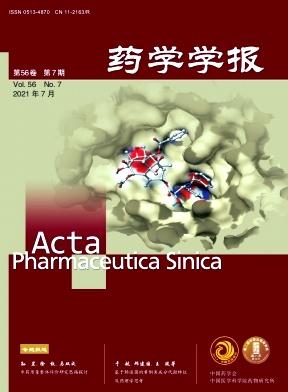[脱氧五味子甲素对NLRP3炎性体的抑制作用及机制]。
摘要
本研究旨在探讨脱氧五味子甲素对NLRP3 (nod样受体家族,pyrin结构域3)炎性小体活性的抑制作用及其分子机制。我们利用骨髓源性巨噬细胞研究了脱氧五味子甲素对炎性体诱导因子(ATP和尼日利亚菌素)激活炎性体的影响。用CCK-8评价细胞毒作用。Western blot检测细胞上清中IL-1β、caspase-1的表达以及细胞中pro-caspase-1、pro-IL-1β、ASC、NLRP3的表达,检测脱氧五味子素(25、50、100、200 μmol·L(−1))对NLRP3炎症小体活性的抑制作用。采用免疫荧光法观察NF-κB (p65)向细胞核的转运。CCK-8测定结果表明,五味子甲素的最佳浓度为6.25 ~ 400 μmol·L(−1)。脱氧五味子甲素(25、50、100和200 μmol·L(−1))能抑制尼日利亚菌素和ATP引起的NLRP3炎性体的激活,抑制IL-1β的分泌,这与抑制caspase-1前的裂解有关。免疫荧光和Western blot结果也表明,脱氧五味子甲素对NLRP3炎性小体的抑制活性不依赖于NF-κB通路以及NF-κB介导的NLRP3、ASC、前caspase-1和前il -1β蛋白的表达。结果表明,在25 ~ 200 μmol·L−1的浓度下,脱氧五味子甲素可以抑制caspase-1裂解,抑制NLRP3炎症小体的活性,从而减轻炎症反应。本研究旨在探讨脱氧五味子甲素对NLRP3 (nod样受体家族,pyrin结构域3)炎性小体活性的抑制作用及其分子机制。我们利用骨髓源性巨噬细胞研究了脱氧五味子甲素对炎性体诱导因子(ATP和尼日利亚菌素)激活炎性体的影响。用CCK-8评价细胞毒作用。Western blot检测细胞上清中IL-1β、caspase-1的表达以及细胞中pro-caspase-1、pro-IL-1β、ASC、NLRP3的表达,检测脱氧五味子素(25、50、100、200 μmol·L(-1))对NLRP3炎症小体活性的抑制作用。采用免疫荧光法观察NF-κB (p65)向细胞核的转运。CCK-8测定结果表明,五味子甲素的最佳浓度为6.25 ~ 400 μmol·L(-1)。脱氧五味子甲素(25、50、100和200 μmol·L(-1))可抑制尼日利亚菌素和ATP引起的NLRP3炎性体的激活,抑制IL-1β的分泌,这与抑制前caspase-1的裂解有关。免疫荧光和Western blot结果也表明,脱氧五味子甲素对NLRP3炎性小体的抑制活性不依赖于NF-κB通路,也不依赖于NF-κB介导的NLRP3、ASC、前caspase-1和前il -1β蛋白表达。结果表明,在25 ~ 200 μmol·L(-1)的浓度下,脱氧五味子甲素可以抑制caspase-1裂解,抑制NLRP3炎症小体的活性,从而减轻炎症反应。This study was conducted to investigate the inhibitory effect and the molecular mechanism of deoxyschizandrin on the activity of NLRP3 (NOD-like receptor family, pyrin domain containing 3) inflammasome. Bone marrow-derived macrophages were used to study the effects of deoxyschizandrin on inflammasome activation using inflammasome inducers (ATP and nigericin). Cytotoxic effect was evaluated with CCK-8. The expression of IL-1β, caspase-1 in the supernatant and the expression of pro-caspase-1, pro-IL-1β, ASC, NLRP3 in cell was detected by Western blot for the inhibitory effect of deoxyschizandrin (25, 50, 100 and 200 μmol·L(−1)) on the activity of NLRP3 inflammasome. Immunofluorescence was applied to investigate NF-κB (p65) transportation to the nucleus. The results of CCK-8 showed that the optimum concentration of deoxyschizandrin was 6.25–400 μmol·L(−1). Deoxyschizandrin (25, 50, 100, and 200 μmol·L(−1)) could inhibit the activation of NLRP3 inflammasome caused by nigericin and ATP, and inhibit the secretion of IL-1β, which was associated with inhibiting the cleavage of pro-caspase-1. The results of immunofluorescence and Western blot also suggest that the inhibitory activity of deoxyschizandrin on NLRP3 inflammasome was not dependent on NF-κB pathway and protein expression of NLRP3, ASC, pro-caspase-1 and pro-IL-1β mediated by NF-κB. Our results confirmed that deoxyschizandrin could suppress the cleavage of pro-caspase-1 and inhibit the activity of NLRP3 inflammasome at 25–200 μmol·L−1 to reduce the inflammation response.This study was conducted to investigate the inhibitory effect and the molecular mechanism of deoxyschizandrin on the activity of NLRP3 (NOD-like receptor family,pyrin domain containing 3) inflammasome.Bone marrow-derived macrophages were used to study the effects of deoxyschizandrin on inflammasome activation using inflammasome inducers (ATP and nigericin). Cytotoxic effect was evaluated with CCK-8.The expression of IL-1β,caspase-1 in the supernatant and the expression of pro-caspase-1,pro-IL-1β,ASC,NLRP3 in cell was detected by Western blot for the inhibitory effect of deoxyschizandrin (25, 50, 100 and 200 μmol·L(-1)) on the activity of NLRP3 inflammasome. Immunofluorescence was applied to investigate NF-κB (p65) transportation to the nucleus. The results of CCK-8 showed that the optimum concentration of deoxyschizandrin was 6.25-400 μmol·L(-1). Deoxyschizandrin (25, 50, 100,and 200 μmol·L(-1)) could inhibit the activation of NLRP3 inflammasome caused by nigericin and ATP, and inhibit the secretion of IL-1β, which was associated with inhibiting the cleavage of pro-caspase-1.The results of immunofluorescence and Western blot also suggest that the inhibitory activity of deoxyschizandrin on NLRP3 inflammasome was not dependent on NF-κB pathway and protein expression of NLRP3,ASC,pro-caspase-1 and pro-IL-1βmediated by NF-κB. Our results confirmed that deoxyschizandrin could suppress the cleavage of pro-caspase-1 and inhibit the activity of NLRP3 inflammasome at 25-200 μmol·L(-1) to reduce the inflammation response.

 求助内容:
求助内容: 应助结果提醒方式:
应助结果提醒方式:


